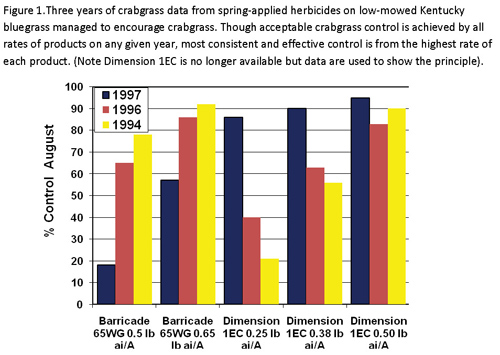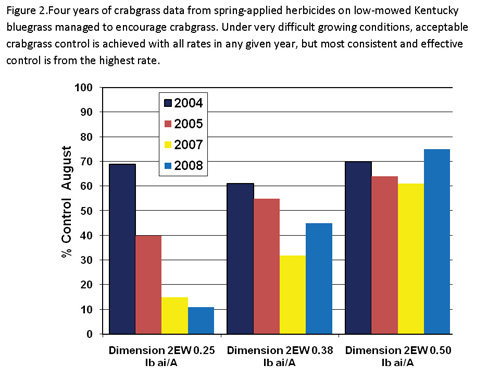As spring is closing in, we are fielding a number of questions four major questions right now:
-
Which preemergence herbide to use?
That one is pretty easy. We have only three active ingredients relatively easily available and they are dithiopyr, pendimethalin, and prodiamine. Our research shows that as long as they are applied at reasonable rates, these three tend to perform similarly for season-long crabgrass control. In any given year, one active ingredient may out-perform the other two or vice versa, but overall these three are effective. -
What rate should I use?
Much tougher question and depends on your location, the density and age of turf, if it’s a “hot spot” or not, if split applications will be used, do you want to make early spring applications in round one or do you hold off until April or May for your first applications, and on and on. The companion Turf Tips to this one discuss many aspects of application rates and my rule of thumb is always to error on the high end of the rate range. Regardless of the active ingredient, you may get by with a low rate on any given year in a relatively cool summer. However, the “cool” summers are far and few between in Indiana and only the high rates of these active ingredients perform consistently in difficult summers. This is shown in our data from the 1990’s in Figure 1, as the most consistently effective control is seen at the high rate of either Barricade or Dimension EC. Do the low rates of the herbicides work? Sure, but only on one or two of the three years. Figure 2 shows more recent data with the newer formulation of Dimension and the same trends hold true. So if you’re willing to play poor odds and bet on a cool summer, go with the lower rates. But if you want consistent and effective control almost regardless of the weather, use the higher rates. -
What about split applications?
Split applications should be used throughout the southern ½ of Indiana for sure and I am to the point of encouraging split applications in any Indiana lawn or area with a history of crabgrass problems. For “hot spots” next to sidewalks, drives, etc. throughout the state, consider applying a preemergence herbicide over the entire lawn in the spring and then only apply to the bordering hotspots in mid-May to June. The first application should be made anytime early spring and the second application made in mid-May to June. This is an effective method to extend the duration of control. Conventional wisdom and our earlier data suggest the same active ingredient should be used in both applications. Our more recent data suggests that we may have more flexibility in changing active ingredients, but we don’t have enough data to confidently recommend that yet. Therefore, depending on the product, applying ½ to 2/3 the total rate in spring plus ½ to 1/3 in the sequential is typical. -
Can I cut down on the overall amount of herbicide that I use?
Though I would avoid reducing the application rates of typical early spring preemergence applications, you might consider dropping the preemergence herbicide out of the first round (early spring) application entirely in favor of a pre/post product in second round. Dithiopyr would be the smartest choice for this strategy because it would be far less expensive than combining quinclorac plus a preemergent herbicide. We consistently find good season-long control from dithiopyr-containing products applied shortly after germination of crabgrass (but don’t skimp on the rate).
 |
 |